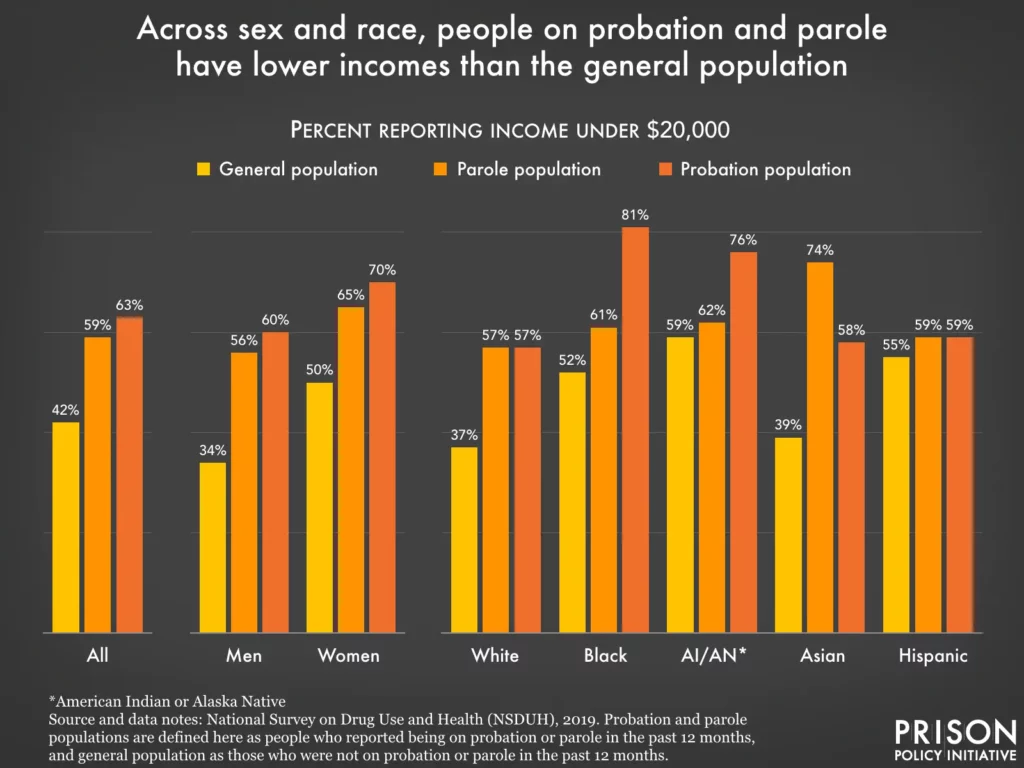Unique survey data reveal that people under community supervision have high rates of substance use and mental health disorders and extremely limited access to healthcare, likely contributing to the high rates of mortality.
by Emily Widra and Alexi Jones, Prison Policy Initiative, April 3, 2023
Research shows that people on probation and parole have high mortality rates: two and three times higher than the public at large.
That certainly suggests that our community supervision systems are failing at their most important — and basic — function: ensuring people on probation and parole succeed in the community.
With a similar approach to our recent series regarding the needs of people incarcerated in state prisons, we did a deep dive into the extensive National Survey on Drug Use and Health (NSDUH). The results of this survey, administered by the U.S. Department of Health and Human Services’ Substance Abuse and Mental Health Services Administration (SAMHSA), provide key insights into these specific — and often unmet — needs faced by people under community supervision. Because this survey asks respondents if they were on probation or parole in the past 12 months, this dataset comes closer than any other source to offering a recent, descriptive, nationally representative picture of the population on probation and parole.
The data that we uncovered — and the analyses of this same dataset by other researchers discussed throughout — reveal that people under community supervision have high rates of substance use and mental health disorders and extremely limited access to healthcare, likely contributing to the high rates of mortality. Moreover, the data show that people on probation and parole experience high rates of chronic health conditions and disability, are extremely economically marginalized, and have family obligations that can interfere with the burdensome — often unnecessary — conditions of probation and parole.
Substance use and mental health
Three in 10 people under community supervision have substance use disorders, four times the rate of substance use disorders in the general population. Similarly, 1 in 5 people under community supervision has a mental health disorder, twice the rate of the general populationIn addition, NSDUH data illustrate that most people on probation and parole do not have adequate access to healthcare, implying that probation and parole offices are failing to match people with the services they need to succeed in the community. Nearly one-third of people on probation and parole with a mental health disorder report an unmet need for mental health treatment. Over two-thirds of people with substance use disorders report needing treatment, but not receiving it. Similarly, only about one-third of people on community supervision with opioid use disorder report receiving medication-assisted treatment (MAT), the “gold standard” of care.
Finally, many people on probation and parole have no health insurance, even though many people on probation and parole have incomes low enough to qualify them for Medicaid. 25% of people on probation and 27% of people on parole were uninsured at the time of this survey. This lack of treatment access reported by people under community supervision represents a massive failure of probation and parole offices.
Physical health and well-being
Criminal legal system involvement is concentrated among people who are socioeconomically disadvantaged and these same populations are at an elevated risk for a number of negative health outcomes. Public health researchers Winkelman, Phelps, Mitchell, Jennings, & Shlafer (2020) analyzed the same NSDUH data (but from 2015-2016) and found that people under community supervision are more likely to report fair or poor health, more chronic conditions, a diagnosis of COPD, hepatitis B or C, or kidney disease than people in the general population.
The community supervision population also has higher rates of disabilities, with particularly high rates of cognitive disabilities. Such disabilities can interfere with individuals’ ability to keep track of the 18 to 20 requirements a day people on probation must typically comply with. The particularly high rates of all types of disabilities among people on probation and parole also reflects the larger pattern of criminalizing people with disabilities.
Economic disadvantage, education, and children

The NSDUH data also indicate that people on probation and parole are extremely economically marginalized, which can interfere with probation and parole conditions. 3 out of 5 people on probation have incomes below $20,000 per year, with women and Black people having among the lowest incomes. More than half have a high school education or less. And people on probation and parole are three times more likely to be unemployed than the general population. Yet, as we have discussed before, people on probation and parole are required to pay unaffordable fees and costs associated with their supervision conditions (such as drug testing or ignition interlock devices), even though many are living well below the poverty line.
